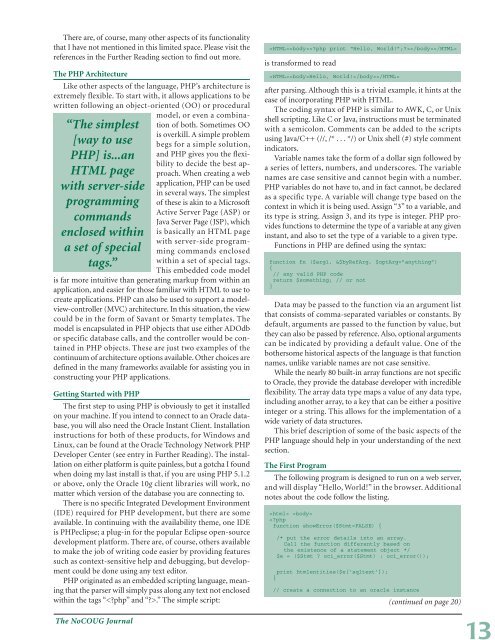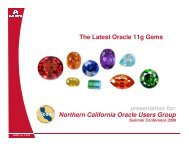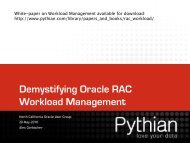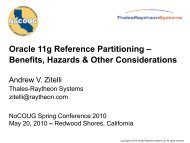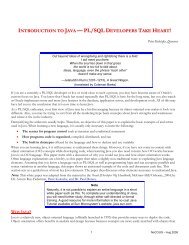Q&A with Juan Loaiza Stay Focused on the Five Steps ... - NoCOUG
Q&A with Juan Loaiza Stay Focused on the Five Steps ... - NoCOUG
Q&A with Juan Loaiza Stay Focused on the Five Steps ... - NoCOUG
Create successful ePaper yourself
Turn your PDF publications into a flip-book with our unique Google optimized e-Paper software.
There are, of course, many o<strong>the</strong>r aspects of its functi<strong>on</strong>ality<br />
that I have not menti<strong>on</strong>ed in this limited space. Please visit <strong>the</strong><br />
references in <strong>the</strong> Fur<strong>the</strong>r Reading secti<strong>on</strong> to find out more.<br />
The PHP Architecture<br />
Like o<strong>the</strong>r aspects of <strong>the</strong> language, PHP’s architecture is<br />
extremely flexible. To start <str<strong>on</strong>g>with</str<strong>on</strong>g>, it allows applicati<strong>on</strong>s to be<br />
written following an objectoriented (OO) or procedural<br />
model, or even a combina<br />
“The simplest<br />
[way to use<br />
PHP] is...an<br />
HTML page<br />
<str<strong>on</strong>g>with</str<strong>on</strong>g> serverside<br />
programming<br />
commands<br />
enclosed <str<strong>on</strong>g>with</str<strong>on</strong>g>in<br />
a set of special<br />
tags.”<br />
The <strong>NoCOUG</strong> Journal<br />
ti<strong>on</strong> of both. Sometimes OO<br />
is overkill. A simple problem<br />
begs for a simple soluti<strong>on</strong>,<br />
and PHP gives you <strong>the</strong> flexibility<br />
to decide <strong>the</strong> best approach.<br />
When creating a web<br />
applicati<strong>on</strong>, PHP can be used<br />
in several ways. The simplest<br />
of <strong>the</strong>se is akin to a Microsoft<br />
Active Server Page (ASP) or<br />
Java Server Page (JSP), which<br />
is basically an HTML page<br />
<str<strong>on</strong>g>with</str<strong>on</strong>g> serverside programming<br />
commands enclosed<br />
<str<strong>on</strong>g>with</str<strong>on</strong>g>in a set of special tags.<br />
This embedded code model<br />
is far more intuitive than generating markup from <str<strong>on</strong>g>with</str<strong>on</strong>g>in an<br />
applicati<strong>on</strong>, and easier for those familiar <str<strong>on</strong>g>with</str<strong>on</strong>g> HTML to use to<br />
create applicati<strong>on</strong>s. PHP can also be used to support a modelviewc<strong>on</strong>troller<br />
(MVC) architecture. In this situati<strong>on</strong>, <strong>the</strong> view<br />
could be in <strong>the</strong> form of Savant or Smarty templates. The<br />
model is encapsulated in PHP objects that use ei<strong>the</strong>r ADOdb<br />
or specific database calls, and <strong>the</strong> c<strong>on</strong>troller would be c<strong>on</strong>tained<br />
in PHP objects. These are just two examples of <strong>the</strong><br />
c<strong>on</strong>tinuum of architecture opti<strong>on</strong>s available. O<strong>the</strong>r choices are<br />
defined in <strong>the</strong> many frameworks available for assisting you in<br />
c<strong>on</strong>structing your PHP applicati<strong>on</strong>s.<br />
Getting Started <str<strong>on</strong>g>with</str<strong>on</strong>g> PHP<br />
The first step to using PHP is obviously to get it installed<br />
<strong>on</strong> your machine. If you intend to c<strong>on</strong>nect to an Oracle database,<br />
you will also need <strong>the</strong> Oracle Instant Client. Installati<strong>on</strong><br />
instructi<strong>on</strong>s for both of <strong>the</strong>se products, for Windows and<br />
Linux, can be found at <strong>the</strong> Oracle Technology Network PHP<br />
Developer Center (see entry in Fur<strong>the</strong>r Reading). The installati<strong>on</strong><br />
<strong>on</strong> ei<strong>the</strong>r platform is quite painless, but a gotcha I found<br />
when doing my last install is that, if you are using PHP 5.1.2<br />
or above, <strong>on</strong>ly <strong>the</strong> Oracle 10g client libraries will work, no<br />
matter which versi<strong>on</strong> of <strong>the</strong> database you are c<strong>on</strong>necting to.<br />
There is no specific Integrated Development Envir<strong>on</strong>ment<br />
(IDE) required for PHP development, but <strong>the</strong>re are some<br />
available. In c<strong>on</strong>tinuing <str<strong>on</strong>g>with</str<strong>on</strong>g> <strong>the</strong> availability <strong>the</strong>me, <strong>on</strong>e IDE<br />
is PHPeclipse; a plugin for <strong>the</strong> popular Eclipse opensource<br />
development platform. There are, of course, o<strong>the</strong>rs available<br />
to make <strong>the</strong> job of writing code easier by providing features<br />
such as c<strong>on</strong>textsensitive help and debugging, but development<br />
could be d<strong>on</strong>e using any text editor.<br />
PHP originated as an embedded scripting language, meaning<br />
that <strong>the</strong> parser will simply pass al<strong>on</strong>g any text not enclosed<br />
<str<strong>on</strong>g>with</str<strong>on</strong>g>in <strong>the</strong> tags “.” The simple script:<br />
<br />
is transformed to read<br />
Hello, World!<br />
after parsing. Although this is a trivial example, it hints at <strong>the</strong><br />
ease of incorporating PHP <str<strong>on</strong>g>with</str<strong>on</strong>g> HTML.<br />
The coding syntax of PHP is similar to AWK, C, or Unix<br />
shell scripting. Like C or Java, instructi<strong>on</strong>s must be terminated<br />
<str<strong>on</strong>g>with</str<strong>on</strong>g> a semicol<strong>on</strong>. Comments can be added to <strong>the</strong> scripts<br />
using Java/C++ (//, /* . . . */) or Unix shell (#) style comment<br />
indicators.<br />
Variable names take <strong>the</strong> form of a dollar sign followed by<br />
a series of letters, numbers, and underscores. The variable<br />
names are case sensitive and cannot begin <str<strong>on</strong>g>with</str<strong>on</strong>g> a number.<br />
PHP variables do not have to, and in fact cannot, be declared<br />
as a specific type. A variable will change type based <strong>on</strong> <strong>the</strong><br />
c<strong>on</strong>text in which it is being used. Assign “3” to a variable, and<br />
its type is string. Assign 3, and its type is integer. PHP provides<br />
functi<strong>on</strong>s to determine <strong>the</strong> type of a variable at any given<br />
instant, and also to set <strong>the</strong> type of a variable to a given type.<br />
Functi<strong>on</strong>s in PHP are defined using <strong>the</strong> syntax:<br />
functi<strong>on</strong> fn ($arg1, &$byRefArg, $optArg=”anything”)<br />
{<br />
// any valid PHP code<br />
return $something; // or not<br />
}<br />
Data may be passed to <strong>the</strong> functi<strong>on</strong> via an argument list<br />
that c<strong>on</strong>sists of commaseparated variables or c<strong>on</strong>stants. By<br />
default, arguments are passed to <strong>the</strong> functi<strong>on</strong> by value, but<br />
<strong>the</strong>y can also be passed by reference. Also, opti<strong>on</strong>al arguments<br />
can be indicated by providing a default value. One of <strong>the</strong><br />
bo<strong>the</strong>rsome historical aspects of <strong>the</strong> language is that functi<strong>on</strong><br />
names, unlike variable names are not case sensitive.<br />
While <strong>the</strong> nearly 80 builtin array functi<strong>on</strong>s are not specific<br />
to Oracle, <strong>the</strong>y provide <strong>the</strong> database developer <str<strong>on</strong>g>with</str<strong>on</strong>g> incredible<br />
flexibility. The array data type maps a value of any data type,<br />
including ano<strong>the</strong>r array, to a key that can be ei<strong>the</strong>r a positive<br />
integer or a string. This allows for <strong>the</strong> implementati<strong>on</strong> of a<br />
wide variety of data structures.<br />
This brief descripti<strong>on</strong> of some of <strong>the</strong> basic aspects of <strong>the</strong><br />
PHP language should help in your understanding of <strong>the</strong> next<br />
secti<strong>on</strong>.<br />
The First Program<br />
The following program is designed to run <strong>on</strong> a web server,<br />
and will display “Hello, World!” in <strong>the</strong> browser. Additi<strong>on</strong>al<br />
notes about <strong>the</strong> code follow <strong>the</strong> listing.<br />
<br />


